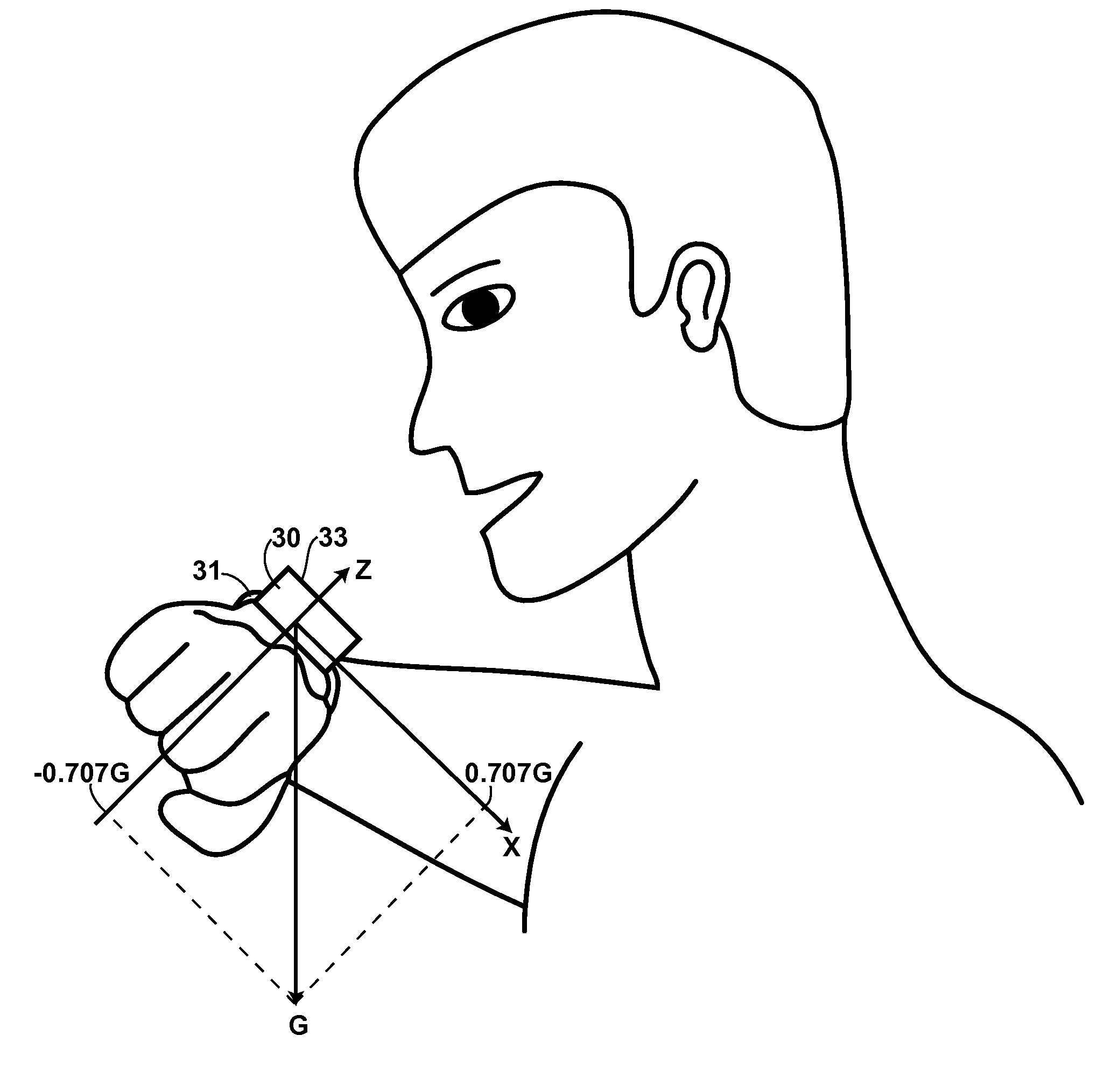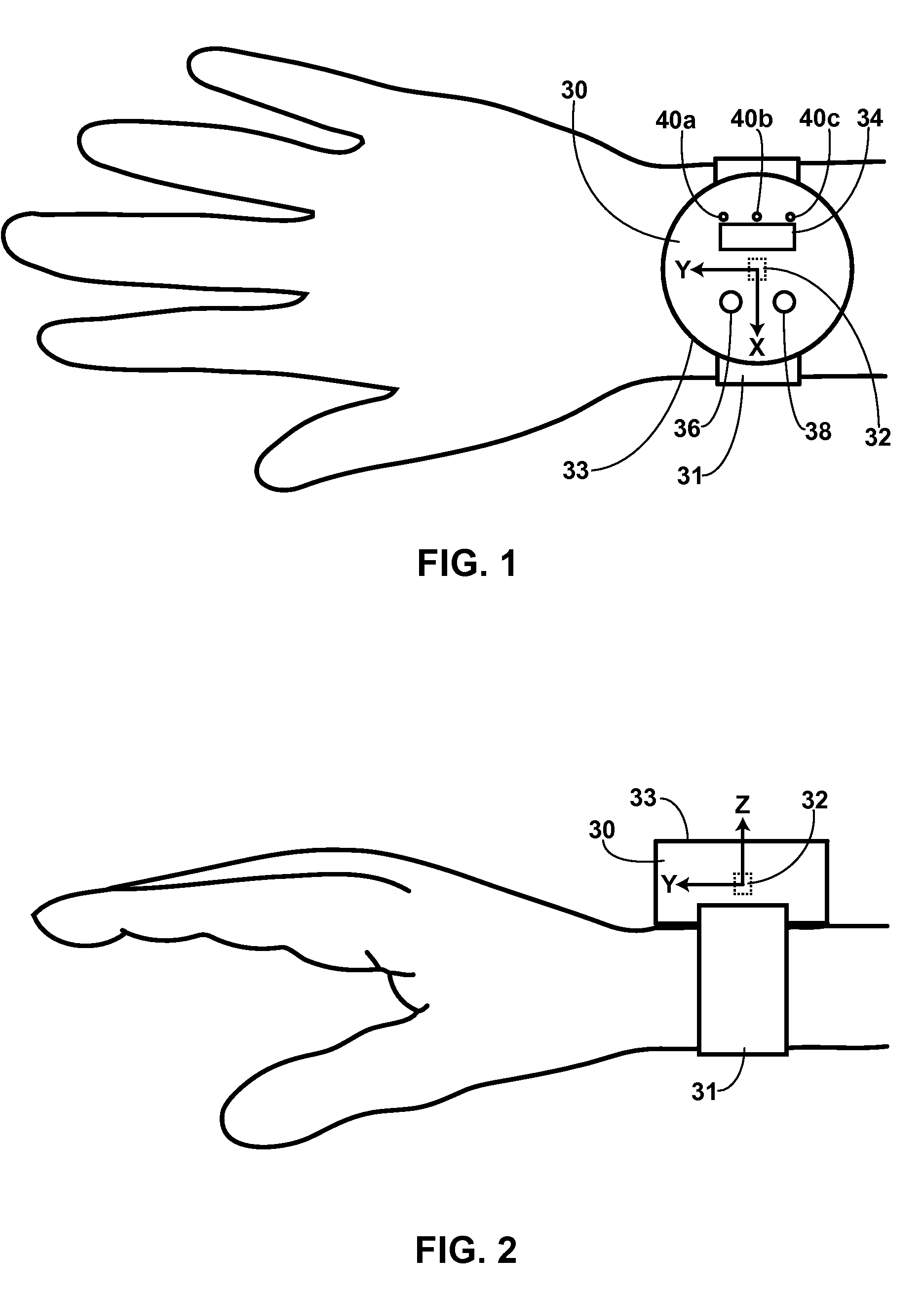Accelerometer-Based Control of Wearable Devices
a technology of accelerometer and wearable device, which is applied in the direction of electric winding, instruments, horology, etc., can solve the problems of premature failure of audio recorder or talking watch, difficult operation, and inability to meet the needs of wearers,
- Summary
- Abstract
- Description
- Claims
- Application Information
AI Technical Summary
Problems solved by technology
Method used
Image
Examples
first embodiment
—FIGS. 1, 2, 3, AND 4—FIRST EMBODIMENT
[0036]The use of accelerometer-based orientation and / or movement sensing to control a wearable device is illustrated in a first embodiment with a wrist-worn audio recorder. The wrist-worn audio recorder incorporates an accelerometer for sensing the orientation and / or movement (i.e. either orientation or movement or both) of the audio recorder, and it is activated to record audio messages only when it is in a predetermined orientation and / or after it has completed a predetermined movement. In this embodiment we describe the predetermined orientation and / or movement to be the natural orientation and / or movement for the user to record personal audio messages, so that the user does not need to actively remember to turn the audio recorder on and off, but the predetermined orientation and / or movement can be any other orientation and / or movement. The wrist-worn audio recorder may usually also contain a real-time clock, so that the recorder can provide ...
second embodiment
DETAILED DESCRIPTION—FIGS 9—SECOND EMBODIMENT
[0053]The use of accelerometer-based orientation and / or movement sensing in a second embodiment for controlling a wearable electronic device is illustrated with a wearable audio recorder in FIG. 9, which is a block diagram of the audio recorder. The audio recorder of the second embodiment incorporates an accelerometer for sensing the orientation and / or movement (i.e. sequence of acceleration data) of the audio recorder, and a predetermined orientation and / or movement of the audio recorder activates playback of a reminding message. The reminding messages can be audio messages (i.e. voice messages, musical sounds, songs, alarms, or computer generated audio tones or messages) recorded in accordance with the first embodiment or in any other way, or they can be non-audio, such as vibration of the audio recorder.
[0054]In FIG. 9, a wrist-worn audio recorder 170 incorporates a three-axis accelerometer 172 for sensing the orientation and / or moveme...
third embodiment
DETAILED DESCRIPTION—FIGS. 13, 14, AND 15—THIRD EMBODIMENT
[0064]The use of accelerometer-based orientation and / or movement sensing in a third embodiment for controlling a wearable device is illustrated with a wristwatch. The wristwatch incorporates an accelerometer for sensing the orientation and / or movement of the wristwatch, and a predetermined orientation and / or movement of the wristwatch, such as the user moving it up and towards the ear, activates audio reporting of the time. This accelerometer-based time-reporting function can also be incorporated in other wrist-worn devices such as the voice recorder described in the first embodiment.
[0065]FIG. 13 shows a front view of a wristwatch 330 incorporating a three-axis accelerometer 332 inside a housing 333 of wristwatch 330. Three-axis accelerometer 332 is commonly also called a triaxial accelerometer, and it senses acceleration in the three orthogonal axes X, Y, and Z. In FIG. 13, accelerometer 332 is illustrated by a dotted outli...
PUM
 Login to View More
Login to View More Abstract
Description
Claims
Application Information
 Login to View More
Login to View More - R&D
- Intellectual Property
- Life Sciences
- Materials
- Tech Scout
- Unparalleled Data Quality
- Higher Quality Content
- 60% Fewer Hallucinations
Browse by: Latest US Patents, China's latest patents, Technical Efficacy Thesaurus, Application Domain, Technology Topic, Popular Technical Reports.
© 2025 PatSnap. All rights reserved.Legal|Privacy policy|Modern Slavery Act Transparency Statement|Sitemap|About US| Contact US: help@patsnap.com



